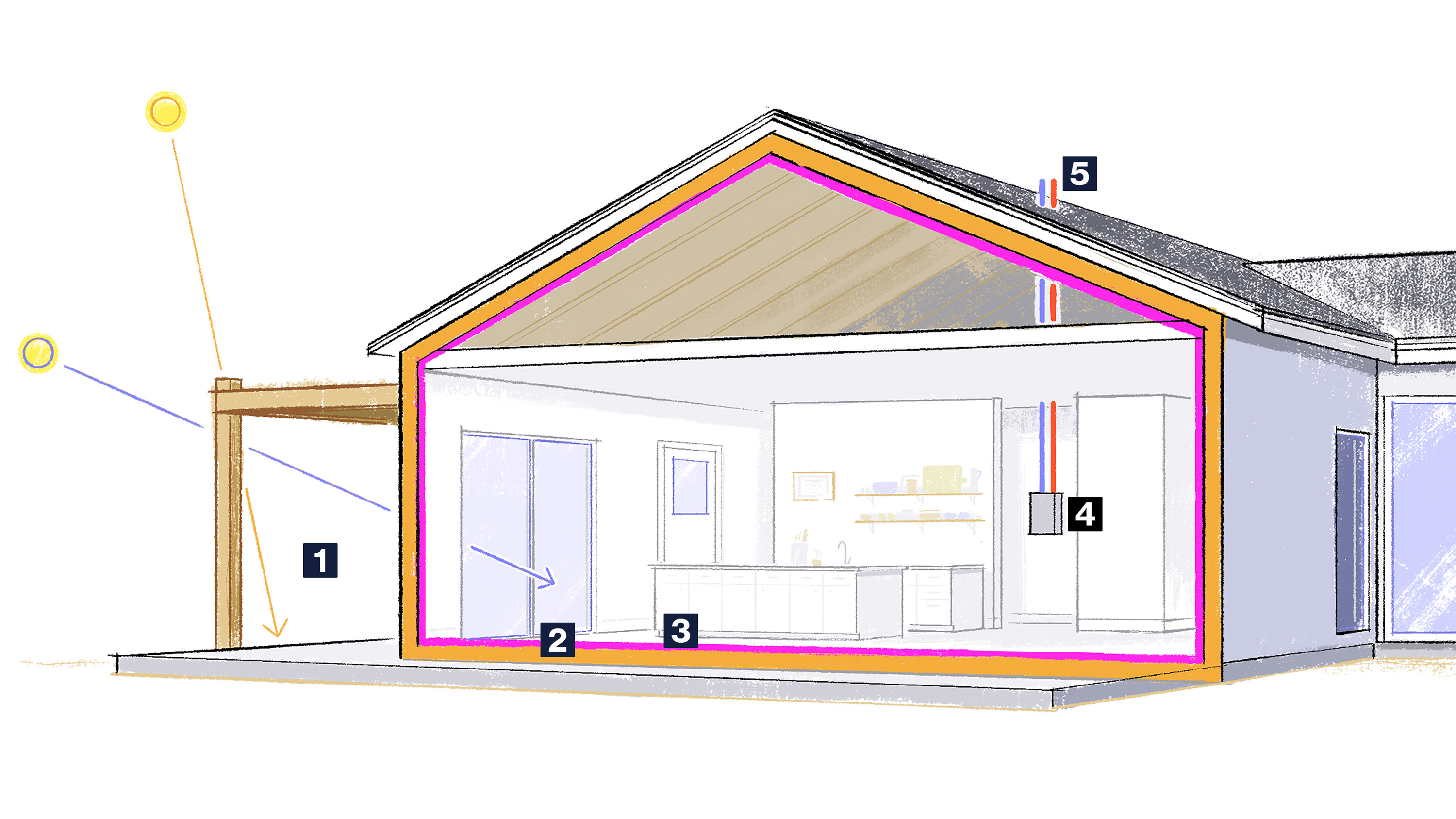Is this the most energy-efficient way to build homes?
Airtight and super-insulated, a passive house uses around 90% less energy.
When the Canadian engineer Harold Orr and his colleagues began designing an ultra-efficient home in Saskatchewan in the late ’70s, responding to a provincial conservation mandate during the oil embargo, they knew that the trick wasn’t generating energy in a greener way, but using less of it. They needed to make a better thermos, not a cheaper coffee maker.

1
High-performance windows with orientation and shading
Heat loss and gain through standard windows accounts for 25% to 30% of residential energy use.
2
Airtight building
envelope
Keeping air, and thus heat, from leaking out or in further reduces the need for heating and cooling.
3
Climate-appropriate
insulation levels
Some homes are even built entirely from insulating materials to minimize the need for energy supply.
4
Thermal-bridge-free design
Weak points in a building envelope that allow heat to drain out of a house are eliminated.
5
Continuous ventilation
with heat recovery
Fresh, filtered air enters the home through a heat recovery ventilation (HRV) system.
The result was the 1978 Saskatchewan Conservation House, a cedar-clad trapezoid that cut energy usage by 85%—and helped inspire today’s globally recognized passive-house standard for building design. Adopted by thousands of buildings comprising tens of thousands of housing units, this concept marries vernacular building techniques, like orienting toward the sun, with cutting-edge insulation and air circulation systems. The formula for these efficient homes, standardized and shared by the German physicist Wolfgang Feist and the Swedish structural engineer Bo Adamson beginning in 1988, also bestows health benefits. With airtight exteriors and better air circulation, these homes offer improved interior air quality and significant noise reduction.
Passive houses now account for less than 1% of multifamily construction.
It’s a marriage of efficiency and rigorously applied physics, says Bronwyn Barry, a passive-house pioneer and principal of a Bay Area architecture firm. If homes are machines for living, passive-house design principles offer a blueprint for a better machine, highlighting just how poorly constructed postwar suburban sprawl can be.
Passive design focuses on the exterior, or envelope, which needs to be tightly insulated to avoid allowing heat out or unwanted heat in. This means using thick thermal insulation and high-quality, often triple-pane windows, which let in the sun’s light and warmth but keep heat from escaping. Heat loss (and, in warm weather, gain) through standard windows necessitates 25% to 30% of residential energy use. Construction also eliminates thermal bridges, or breaks in the envelope or insulation that allow heat to drain out. Think “boxy but beautiful,” as Barry once wrote: houses boast continuous layers of insulation while minimizing the cantilevers, corners, dormers, and other features that characterize the messy rooflines of McMansions. These design requirements result in airtight buildings, as measured by a blower door test: after a specially calibrated door-mounted fan sucks air out of the house to lower the air pressure inside, technicians look for gaps and cracks where higher-pressure air from the outside flows in.
While this single-minded focus on efficiency, or building the best thermos, leads to exceptional performance—up to a 90% reduction in heating and cooling demand—passive houses can’t circulate air like traditional builds. But heat recovery ventilators or energy recovery ventilators can address that problem, exchanging air without sacrificing interior heat.
Often considered a cold-climate approach, passive houses actually have universal benefits. Warmer climates simply require different windows and exteriors, and additional shading to combat excessive heat gain.
The passive-house movement has expanded well beyond single-family homes and the German and Nordic regions where it’s most popular. There are now 275-plus finished multifamily projects in the US alone, including dorms at Cornell University, scores of affordable housing projects across New York City, and the newly opened Winthrop Center, a 53-story skyscraper in downtown Boston. But even though the Passive House Network, an educational organization for the building industry, has found that costs are competitive for these large-scale projects, and incentives introduced by the Biden administration through the Inflation Reduction Act could decrease costs even more, passive houses still account for less than 1% of all multifamily construction in the US in the past decade.
Patrick Sisson, a Chicago expat living in Los Angeles, covers technology and urbanism.
Deep Dive
Climate change and energy
The race to get next-generation solar technology on the market
Companies say perovskite tandem solar cells are only a few years from bringing record efficiencies to a solar project near you.
Super-efficient solar cells: 10 Breakthrough Technologies 2024
Solar cells that combine traditional silicon with cutting-edge perovskites could push the efficiency of solar panels to new heights.
Heat pumps: 10 Breakthrough Technologies 2024
Heat pumps are a well-established technology. Now they’re starting to make real progress on decarbonizing homes, buildings, and even manufacturing.
Developing climate solutions with green software
Deploying sustainable software practices can reduce emissions and infuse greater efficiency, resiliency, and cost-effectiveness, says director of green software and ecosystems at Intel, Asim Hussain.
Stay connected
Get the latest updates from
MIT Technology Review
Discover special offers, top stories, upcoming events, and more.